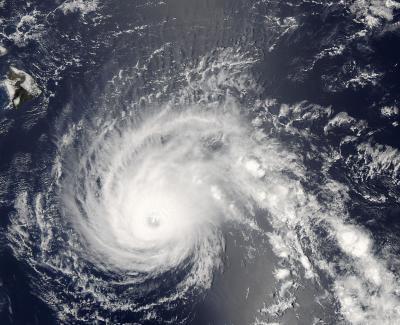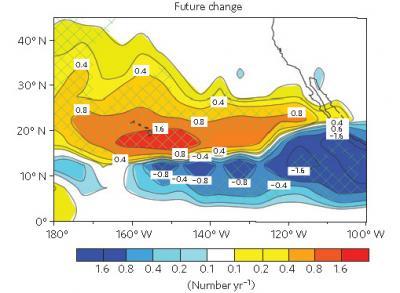Hawaii does not get a lot of hurricanes, only two have made landfall in the last 30 years.
But scientists at the International Pacific Research Center, University of Hawaii at Manoa predict that Hawaii could see a two-to-three-fold increase in tropical cyclones by 2075.
How worried should Hawaii residents get?
Climate models have predicted fewer hurricanes overall but with so many variables in a complex system like the climate, it is hard to be sure a numerical model can accurately predict hurricane frequency in a local area.
To try and get an answer, lead author Hiroyuki Murakami and Bin Wang in the Meteorology Department of the University of Hawaii at Manoa teamed up with Akio Kitoh at the Meteorological Research Institute and the University of Tsukuba in Japan. They compared in a state-of-the-art, high-resolution global climate model the recent history of tropical cyclones in the North Pacific with a future (2075–2099) scenario under which greenhouse gas emissions continue to rise, result in a temperatures about 2°C higher than today.

Hurricane Flossie approaches the big island of Hawaii, August of 2007. Credit: NASA
"In our study, we looked at all tropical cyclones, which range in intensity from tropical storms to full-blown category 5 hurricanes. From 1979 to 2003, both observational records and our model document that only every four years on average did a tropical cyclone come near Hawaii. Our projections for the end of this century show a two-to-three-fold increase for this region," explains Murakami.
The main factors they cite as responsible for the increase are changes in the large-scale moisture conditions, the flow patterns in the wind, and in surface temperature patterns stemming from global warming.
Most hurricanes that might threaten Hawaii now are born in the eastern Pacific, south of the Baja California Peninsula. From June through November the ingredients there are just right for tropical cyclone formation, with warm ocean temperatures, lots of moisture, and weak vertical wind shear. But during the storms' long journey across the 3000 miles to Hawaii, they usually fizzle out due to dry conditions over the subtropical central Pacific and the wind shear from the westerly subtropical jet.

The projected change in number of tropical cyclones per year by the last quarter of this century. The green stippling indicates statistical significance at the 99 percent confidence level. Credit: Hiroyuki Murakami, Nature Climate Change Source: University of Hawaii ‑ SOEST
In their scenario, even though fewer tropical cyclones will form in the eastern Pacific, more of them would make their way to Hawaii. The upper-level westerly subtropical jet will move poleward so that the mean steering flow becomes easterly. So storms from Baja California are much more likely to make it to Hawaii. Furthermore, since the climate models also project that the equatorial central Pacific will heat up, conditions may become more favorable for hurricane formation in the open ocean to the south or southeast of Hawaii.
"Our finding that more tropical cyclones will approach Hawaii as Earth continues to warm is fairly robust because we ran our experiments with different model versions and under varying conditions. The yearly number we project, however, still remains very low," says Wang.
Published in Nature Climate Change





Comments